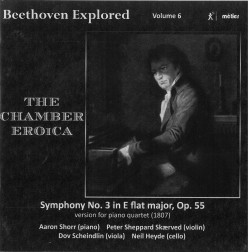 Beethoven Explored – The Chamber Eroica
Beethoven Explored – The Chamber Eroica
Aaron Short; Peter Sheppard Skǽrved; Dov Scheindlin; Neil Heyde
Metier msvcd 2008
(divineartrecords.com)
It may come as a surprise to those of us accustomed to hearing a symphony performed by a full orchestra that during the early 19th century, an adaptation for a much smaller ensemble would have been a perfectly acceptable means of presenting large-scale works, particularly in domestic settings. Indeed, there was an enormous demand for arrangements during the days before recorded music, and this is the idea behind The Chamber Eroica. It’s the sixth in a series titled Beethoven Explored on the British label Metier, and features pianist Aaron Shorr, violinist Peter Sheppard Skǽrved, violist Dov Scheindlin and cellist Neil Heyde in a piano quartet version of Beethoven’s Symphony No.3.
The groundbreaking third symphony was completed in 1804, while this anonymous arrangement – requested by Beethoven himself – was published just three years later. Hence, this recording (the first ever) provides the modern-day listener with a keen insight as to what the composer had in mind with respect to chamber arrangements of his orchestral works. And without the use of period instruments, the four performers admirably evoke a rightful sense of grandeur in this majestic symphony. The opening movement, marked Allegro Moderato, contains a wonderful sense of momentum with the central theme continually being passed among the piano and the strings. The second movement is suitably sombre and mysterious and the third movement scherzo, all lightness and grace. While it would be challenging to duplicate the grandeur of the finale with a four-piece ensemble, the players ably capture its optimistic buoyancy.
In all fairness, there are instances when the arrangement seems not as performer-friendly as it might be. At times, the violist’s range seems uncomfortably high and the strings are sometimes required to perform melodic lines ordinarily given to the woodwinds. But the group remains undaunted and produces a most satisfying sound very much in keeping with the robust spirit of the original work.
The disc is to be commended on two levels: exemplary performances by the four musicians; and for providing the present-day listener with a glimpse into a particular facet of music-making during the early 19th century. Highly recommended.



